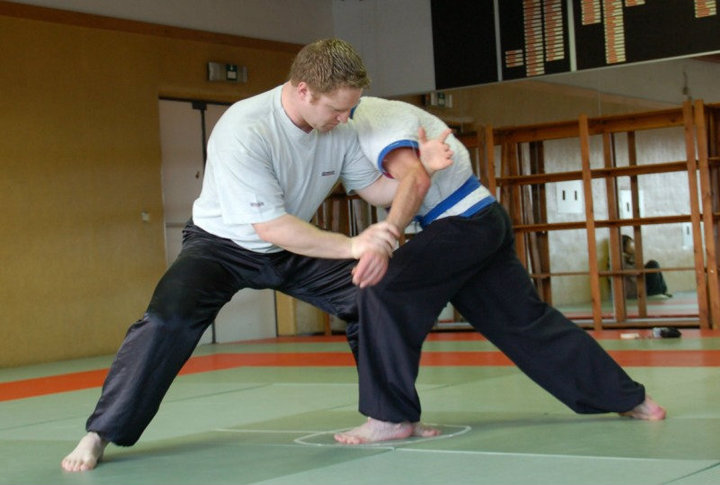Photo: Martin Shkreli
One of the recurring issues I have when teaching self-defense is that many people have trouble understanding their inner dialogue. In particular, how it goes off track and leads them into trouble. There are all kinds of reasons for that, I’m not going into it today. Suffice it to say that it’s something you see all around you, every day, in varying degrees. You see it in the asshole who cuts you off in traffic, almost causing you to run over a pedestrian. Or the idiot who bumps you into an elderly lady because him being late for a meeting is just so important and you barely manage to catch her before she falls (and breaks her brittle bones). We’ve all met those guys.
Funny thing though, if you point out how rude they are and how their actions endanger others, they get all self-righteous on you and somehow you’re the unreasonable one and they’re the victim. As in, how dare you even speak to them like that!
Truth be told, sometimes we’re that guy. Be honest now, you’ve sinned in this department just as I have. There’s a difference though: reasonable people eventually realize they are messing up and become ashamed of their own behavior. Then they try to change their ways. Assholes don’t care, they just keep on going with the bad attitude.
The problem with not caring about anything but yourself is first of all, you’ll eventually start believing your own bullshit:
- You are so much better than everybody else.
- Those losers are so stupid, they’ll never get it.
- Nobody can touch you, you’re so awesome.
- Anybody who tries, you’ll kick his loser ass.
And so on.
The thing these guys don’t understand is that it’s not because people don’t speak back to you or don’t beat the crap out of you for being an egotistical asshole, that they don’t want to. Regular folks don’t always fight over stupid arguments, but they can sure feel like it.
If you scare them a little by turning on your mad monkey vibe, they’ll probably back off. It works, you win. If that happens enough (it often does; being aggressive works very well), then this becomes your reality. You feel it is the natural order of things that you can flip somebody off when they annoy you and never suffer any consequences for it. Why? Well, because the last fifteen times you did it, they cowered and went away. So in your experience, that’s how the world works and you’re absolutely right: in your experience that is certainly the case.
But now we come to a favorite quote of a scientist friend of mine:
The plural of anecdote is not evidence.
Just because that’s how it always turned out for you, doesn’t mean it always will. Just because they didn’t punch you in the face, doesn’t mean they didn’t come close. And you’ll never know why they held back.
Only an idiot thinks everybody else will always restrain themselves like that.
The second problem with being an self-righteous asshole is that because of the dynamics I just described, you eventually get a sense of entitlement about it. It is your right to be an asshole and act as if nobody else matters. Why would you learn to settle matters with a compromise? Why would you even bother seeing things from the other person’s perspective? You’re awesome! Everybody else sucks!
Keep that attitude going long enough and your decision making skills will lead you down a path you can’t return from. It’s just a matter of time before you act self-righteous and obnoxious around somebody who won’t put up with your shit. If you’re lucky, you get out in one piece. If not, well… Here’s a story one of my clients told me a few days ago.
He’s an avid hunter and was out with a friend and his dog, going for game birds. The hunting grounds were close to a river with a path next to it. That path is popular with cyclists and people going for a walk. So they made sure they stopped shooting well before they got to the path. His friend however made the mistake of not putting his dog back on a leash (that’s the law here) and it got in front of a guy on a bike. The guy fell. The friend went over and asked if the guy was alright, said he was sorry, it was his fault and is there anything he could do to help. You can’t really ask for more than somebody owning up to his mistake and offering reparations.
The guy wanted none of it, replied that he should kick the friend’s ass and moved forward. The friend lifted one arm in a defensive posture and the conversation went something like this:
Guy: “Are you scared?”
Friend: “Yes, I am.”
Guy: “You better be.”
After some more huffing and puffing, he got on his bike and left, buzzing my client and missing him by an inch.
Here’s the part he missed:
- The friend is a second degree Judo black belt who can more than hold his own.
- My client had already positioned himself strategically to take the guy out as he threatened the friend.
- My client went into the flinch guard as the guy buzzed him and told me he was sorely tempted to knock him off his bike with the elbow shot we’ve been training for months. The range was good and it would have worked; he hits really hard.
- One of their main concerns was that getting in an altercation while hunting would mean they lose their license if the cops got involved. They didn’t want that so they didn’t act.
If you look at it from another point of view, here’s the story again:
A guy gets self-righteous at a man armed with a hunting rifle who offers him a sincere apology for an honest mistake. The guy doesn’t accept the apology and threatens to assault the armed man, while his trained dog is standing next to him along with his self-defense trained friend who’s also carrying a hunting rifle. The main reason they didn’t act was a piece of paper.
Can you see the disconnect with reality?
Threatening two men armed with firearms and a trained dog? In what universe is that a smart move? Probably in the same one where you say “You don’t have the balls to shoot me?” and then eat a bullet?
This is the kind of slippery slope reasoning self-righteous entitlement leads to. I’ve seen it all over the world, in all layers of society. People get used to treating others like crap and just assume there will never be consequences because so far, there haven’t been any. But they fail to understand that it takes two to tango. They refuse to acknowledge how their behavior puts them in a situation that escalates into violence. A situation in which they don’t come out on top, at best.
When you come to blows with somebody, you are part of the equation. For better or worse, your actions brought you there. Hopefully, you just failed to avoid the problem. But there are also those situations in which you are part of the problem. It would be a mistake to think you can get away with that forever.
So don’t be an asshole.


